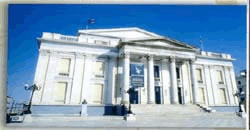PIRAEUS IN THE PAST
Piraeus connotes an eventful history amongst centuries. In ancient times Piraeus was an obscure large village, which consisted of an islet. For that matter, it was given the name it bears up to this day derived from the verb pereo, which means pass through. Later on, that islet connected to land by deposition of torrents’ silts, taking the form of today’ s Piraeus peninsula.
Piraeus flourished in the time of Themistocles (5th c.B.C.), who persuaded the Athenians to take heed of its natural harbour and take an interest in the sea. It was then that fortifications enclosed the peninsula, the “Long Walls” were begun and a great number of ships were built. Cleisthenes, the founder of Athenian Democracy, included Piraeus as a municipality.
Kimon is credited with the first systematic fortification of Piraeus (the North and the Phaleron Wall), while the third or Middle Wall was built at the instance of Pericles.

The old Piraeus
In the Middle Ages, Piraeus was under the name of «Porto Leone» from the marble lion in the mouth of the harbour. In 1687 the lion was removed to Venice by the Venetian admiral Morozini.
During the first year of the Greek Independence Revolution of 1821, Piraeus is on decline since its only inhabitants are ten monks, one trader, two guards and a customs inspector. In 1832, however, there were only twelve shacks in the area.
The Athenians and other travellers made approaches to Piraeus on horseback but transported their luggage on camels.
The rapid development of the port started mainly after the liberation of Greece (from the Turkish yoke) and the transference of the capital from Naples to Athens. Its residents came up to 50,000 in 1895. Within few years Piraeus developed ito the first port of the country, and in particular, it became internationally famous.

The famous statue of the guardian lion of the port of Piraeus
MODERN PIRAEUS
The most significant port in Greece lies at Saronic Golf in the south-west of Attica and is within 9.300m distance of Athens joined virtually to the capital and being its haven. It has got a seat of municipality being established in 1964. The port of Piraeus extends from New Phaleron to Perama, including two smaller natural harbours of Munichia (Mikrolimano), Zea and the great commercial harbour. Besides, Piraeus is one of the most important commercial and industrial hubs in Greece. Almost all the industrial branches have developed like iron metallurgy , chemical industry , foodstuffs , building materials , tobacco industry , electrical and mechanical engineering industries , tannery , oil -and textile- mills , power plant , shipyards and many others of light industry. There also sit shipping agents and ship-owners’ offices.

The commercial and passenger port of Pireaus
Being the chief port of Greece and the biggest in the eastern Mediterranean, it has got a remarkable transport. Along with Athens it is the shipping and railway lines terminal abroad and to the mainland and insular Greece , as well. Electric railway links the capital to its haven. Most of import and export trade is carried out here. The port of Piraeus is equipped with all the state-of-the art facilities. The Port of Piraeus Authority has been assigned the task to organize the port since 1930 , as a legal entity , aiming at the best structural running and maintenance of the port . The population of the city comes up to 300.000 and along with the suburbs to 1.000.000. With its well laid-out streets, good-looking squares and gorgeous buildings, the city has acquired a modern European look.

The marine Zea
|
PIRAEUS AND CULTURE Piraeus abounds with treasures able to satisfy even the most demanding visitor. With its remarkable sightseeing incites every tourist to discover the civilisation concerning Piraeus and Greece generally, whose history covers more than forty centuries. Besides, there exist monuments from antiquity, museums, artefacts, which altogether are a credit to the city itself. Public libraries, galleries as well as a large number of neoclassical buildings, which managed to outlive, constitute living treasures. In the Archaeological Museum the sculptures mainly refer to Piraeus and the general district of Attica. There is also the Marine Museum whose large number of considerable exhibits relate to the sea and various types of vessel. Finally, museums such as «Averof» and «Panos Aravantinos» are of great interest.
|
|
|
|
The Theater of our city PIRAEUS OF ATHLETICS AND SPORTS Piraeus presents a high activity in sports. These days, only in the area of the Municipality there exist twenty six football teams, eight sailing clubs and many others like volley-ball, swimming, water-polo as well as track and field sports.
|
|
|
|
Peace and Friendship Stadium |
Among them the Olympiacos F.C., founded in 1925, is the legend of the city. With its forty four championships, twenty seven cups and many others, it has been the most distinguished team.
Photos of Piraeus:









